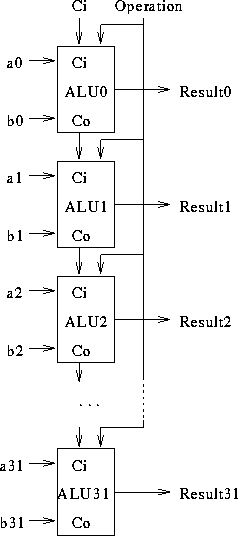Constructing a larger fan-in gate from smaller gates.
Constructing a larger fan-in gate from smaller gates.
Symbol:

Tom Kelliher, CS 240
Feb. 17, 1999
Addition, subtraction, logical operations.
Lookahead.
Important design principle: reuse.
Basic logic gates:
Constructing a larger fan-in gate from smaller gates.
Constructing a larger fan-in gate from smaller gates.
Symbol:

Abbreviated truth table:

Remember: It is a switch. Full truth table, SOP equation, Karnaugh map, implementation.
A one-bit two function logical unit:

Constructing a 4-1 mux from 2-1 muxes.
Recall the addition table:

Write SOP equations for sum and carry-out. Minimize. Implement.
Block diagram:

A one-bit three operation ALU:

A 32-bit three operation ALU:

Ripple carry addition. How fast/slow?
What additional functionality needed?
result = (a - b) < 0
Need signal to indicate that result equals 0.
Inputs: operation, signs of a, b, result.
Why carry-out in Figure 4.17?
Three input lines: